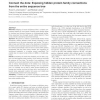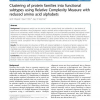97 search results - page 14 / 20 » An evolutionary progressive multiple sequence alignment |
103
click to vote
ECCB
2008
IEEE
15 years 6 months ago
2008
IEEE
Motivation: Mapping of remote evolutionary links is a classic computational problem of much interest. Relating protein families allows for functional and structural inference on u...
115
Voted
GCB
2000
Springer
15 years 3 months ago
2000
Springer
Conventional phylogenetic tree estimation methods assume that all sites in a DNA multiple alignment have the same evolutionary history. This assumption is violated in data sets fro...
101
click to vote
BMCBI
2010
15 years 13 days ago
2010
Background: The incorporation of annotated sequence information from multiple related species in commonly used databases (Ensembl, Flybase, Saccharomyces Genome Database, Wormbase...
BMCBI
2010
15 years 13 days ago
2010
Background: Phylogenetic analysis can be used to divide a protein family into subfamilies in the absence of experimental information. Most phylogenetic analysis methods utilize mu...
104
click to vote
BMCBI
2006
15 years 11 days ago
2006
Background: When accurate models for the divergent evolution of protein sequences are integrated with complementary biological information, such as folded protein structures, anal...


